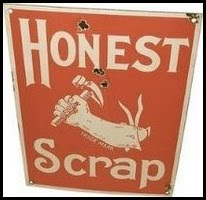
I'm becoming a social butterfly in the blog world. In the last month I've joined several baking groups and today is the first post for the newly formed Bread Baker's Apprentice group, which was started by Nicole over at her blog Pinch My Salt. I found her blog while perusing Peter Reinhart's blog and he had made mention of this new group forming and how they would be baking each recipe from his book The Bread Baker's Apprentice. Well, I have been a huge fan of his since I was in culinary school and have several of his books, including this one. Every recipe I've tried of his, has always turned out great, and so I decided it was time to get back into bread baking more often.
The goal of the BBA group is to make each recipe in the BBA book weekly and I'm going to do what I can to stay on this schedule in going through this book. I own many, and I do mean many cookbooks, but I can't say that I've made every single recipe in even one--so this challenge will be an exciting one and of course I'll be sharing it here each week.
The goal of the BBA group is to make each recipe in the BBA book weekly and I'm going to do what I can to stay on this schedule in going through this book. I own many, and I do mean many cookbooks, but I can't say that I've made every single recipe in even one--so this challenge will be an exciting one and of course I'll be sharing it here each week.
I love cookbooks that give stories or backgrounds of the recipes and this very first one had just that. Here's an excerpt from Peter Reinhart, explaining how this bread's name came to be:
"...I felt duty bound to revisit one of the great New England breads, anadama, and to come up with a definitive version. There are conflicting stories of the origin of the name. Judith and Evan Jones, in their wonderful The Book of Bread, tell the story of a Rockport, Massachusetts, man who was upset with his wife not only for leaving him, but also for leaving behind only a pot of cornmeal mush and some molasses. The angry husband tossed the mush and molasses together with some yeast and flour and muttered, "Anna, damn 'er!" This was later amended by the more genteel local Yankees, as they retold the story, to anadama. Sounds likely to me."
After reading about the name of this bread I just knew it had to be a good one. I wasn't disappointed.

Anadama Bread
The Bread Baker's Apprentice, pgs. 108-110
Day 1 - Soaker
- 1 cup cornmeal, coarse grind (I used a medium grind that worked great)
- 1 cup water, at room temperature
1) The day before making the bread, make the soaker by mixing the cornmeal and water in a small bowl. Cover with plastic wrap and let sit overnight at room temperature.

Day 2 - Dough
- 4 1/2 cups unbleached bread flour (I used 2 cups a/p flour & 2 1/2 cups bread flour)
- 2 tsp. instant yeast (I didn't have instant yeast on hand, so I used a packet of active yeast instead)
- 1 cup water, lukewarm (90 degrees to 100 degrees F)
- 1 1/2 tsp. salt
- 6 Tbsp. molasses (I used Grandma's Molasses - Original)
- 2 Tbsp. shortening or unsalted butter, at room temp. (I prefer using butter, rather than shortening)
- Cornmeal for dusting (optional) *The cornmeal is great and adds an extra texture that works well with this bread.
2) Stir together 2 cups of the flour, the yeast, soaker, and water in a mixing bowl. Cover the bowl with a towel or plastic wrap and ferment for 1 hour, or until the sponge begins to bubble.

3) Add the remaining 2 1/2 cups of flour, the salt, the molasses, and shortening or butter and mix on low speed with the paddle attachment, until the ingredients form a ball.
4) Sprinkle flour on the counter or large cutting board. Move dough to the floured workspace and begin kneading (or mix on medium speed with the dough hook), you may need to add more flour as you knead the dough, enough that it isn't sticking to the counter.

The dough should be firm but supple and pliable and definitely not sticky. It will take about 10 minutes of kneading to accomplish this (or 6 to 8 minutes in the mixer). *I mixed it first in the mixer for about 5-6 minutes, since I never get to use my dough hook. Then I finished kneading it on the counter.

Check the dough by using the windowpane test, if it passes, you are ready for the next step. *Thanks to my "photo helper" aka Mom for holding up the dough.



5) Lightly oil a bowl and transfer the dough to the bowl, rolling it around to coat it with the oil. Cover the bowl with plastic wrap and ferment the dough at room temperature for about 90 minutes, or until it doubles in size.

6) Remove the dough from the bowl and divide it into 2 equal pieces of 24 ounces, or 3 pieces of about 16 ounces. Shape the dough into loaves, and place them into the bread pans that have been lightly oiled or misted with spray oil (the larger loaves should go into 9 x 5-inch pans and the smaller loaves into 8 1/2 x 4 1/2-inch pans). Mist the tops of the loaves with spray oil and loosely cover the tops with plastic wrap. (I used glass pans, and they worked fine--just make sure they are well oiled, so the bread releases easily after being baked.)

7) Proof at room temperature for 60 to 90 minutes, or until the loaves crest fully above the tops of the pans. (If you want to hold back any of the loaves, place them in the refrigerator without proofing, where they will hold, or retard, for up to 2 days. Remove them from the refrigerator about 4 hours before baking and proof them at room temperature, or until ready.)
8) Preheat oven to 350 degrees F with the oven rack on the middle shelf. Place the pans on a sheet pan and remove the plastic wrap. Mist the tops with a spray of water and dust with cornmeal.

9) Place the sheet pan in the oven and bake for 20 minutes. Rotate the sheet pan for even baking and continue to bake for 20 to 30 minutes, or until the loaves are golden brown, including along the sides and bottom, and register at least 185 degrees to 190 degrees F in the center. They should make a hollow sound when thumped on the bottom.
10) When the loaves are done, remove them immediately from the pans and cool on a rack for at least 1 hour before slicing or serving.

*I set the timer for exactly 1 hour and only made it 26 minutes before cutting into the warm, oh-so-awesome smelling bread...


*I set the timer for exactly 1 hour and only made it 26 minutes before cutting into the warm, oh-so-awesome smelling bread...

And the verdict you ask? Well, let's just say that I polished off three slices while it was still warm and yes, I will be making this recipe again.







Lovely looking loaf! And great step-by-step photos!
ReplyDeleteWhat a beautiful bread, and what a good idea, that of the group! I have a couple books by Reinhart, but not this one, even if I knew it was a must have!
ReplyDeleteGreat looking loaves. Glad you joined the group with us. I'll be following your fun. :)
ReplyDeleteSusie
It looks wonderful! Looking forward to baking mine this weekend.
ReplyDeleteAudrey
Very nice!! My "windowpane" looked similar to yours. Thanks for posting the photo!
ReplyDeleteWow, it looks so pro!
ReplyDeleteJill, I am with you, it tasted so good.
ReplyDeleteI joined lots of groups too, and now I am not sure I will be able to do all the challenges. See you at the BBA group.
I am a pastry chef too, but unfortunately I am out of work in this economy, so I am trying to re-invent myself. I will be selling at my town's farmers' market starting in June, and hopefully that will result in something.
Happy to have found your blog!
Wonderful post and bread Jill! Thanks for all the tips and photos
ReplyDeleteLook at that crunchy-delicious cornmeal garnish! Looking forward to Artos!
ReplyDeleteI love Anadama bread. My mom made it all the time when I was growing up. Thanks for sharing the esperience.
ReplyDeleteMelissa